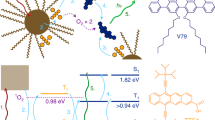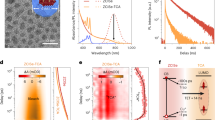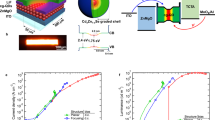Abstract
Optical upconversion via sensitized triplet–triplet exciton annihilation converts incoherent low-energy photons to shorter wavelengths under modest excitation intensities1,2,3. Here, we report a solid-state thin film for infrared-to-visible upconversion that employs lead sulphide colloidal nanocrystals as a sensitizer. Upconversion is achieved from pump wavelengths beyond λ = 1 μm to emission at λ = 612 nm. When excited at λ = 808 nm, two excitons in the sensitizer are converted to one higher-energy state in the emitter at a yield of 1.2 ± 0.2%. Peak efficiency is attained at an absorbed intensity equivalent to less than one sun. We demonstrate that colloidal nanocrystals are an attractive alternative to existing molecular sensitizers, given their small exchange splitting, wide wavelength tunability, broadband infrared absorption, and our transient observations of efficient energy transfer. This solid-state architecture for upconversion may prove useful for enhancing the capabilities of solar cells and photodetectors.
This is a preview of subscription content, access via your institution
Access options
Subscribe to this journal
Receive 12 print issues and online access
$209.00 per year
only $17.42 per issue
Buy this article
- Purchase on Springer Link
- Instant access to full article PDF
Prices may be subject to local taxes which are calculated during checkout




Similar content being viewed by others
References
Singh-Rachford, T. N. & Castellano, F. N. Photon upconversion based on sensitized triplet–triplet annihilation. Coord. Chem. Rev. 254, 2560–2573 (2010).
Schmidt, T. W. & Castellano, F. N. Photochemical upconversion: the primacy of kinetics. J. Phys. Chem. Lett. 5, 4062–4072 (2014).
Schulze, T. F. & Schmidt, T. W. Photochemical upconversion: present status and prospects for its application to solar energy conversion. Energy Environ. Sci. 8, 103–125 (2015).
Zhou, J., Liu, Q., Feng, W., Sun, Y. & Li, F. Upconversion luminescent materials: advances and applications. Chem. Rev. 115, 395–465 (2015).
Trupke, T., Green, M. A. & Würfel, P. Improving solar cell efficiencies by up-conversion of sub-band-gap light. J. Appl. Phys. 92, 4117–4122 (2002).
de Wild, J., Meijerink, A., Rath, J. K., van Sark, W. G. J. H. M. & Schropp, R. E. I. Upconverter solar cells: materials and applications. Energy Environ. Sci. 4, 4835 (2011).
Monguzzi, A. et al. Broadband up-conversion at subsolar irradiance: triplet-triplet annihilation boosted by fluorescent semiconductor nanocrystals. Nano Lett. 14, 6644–6650 (2014).
Cao, X., Hu, B. & Zhang, P. High upconversion efficiency from hetero triplet–triplet annihilation in multiacceptor systems. J. Phys. Chem. Lett. 4, 2334–2338 (2013).
Fückel, B. et al. Singlet oxygen mediated photochemical upconversion of NIR light. J. Phys. Chem. Lett. 2, 966–971 (2011).
Englman, R. & Jortner, J. The energy gap law for radiationless transitions in large molecules. Mol. Phys. 18, 145–164 (1970).
Singh-Rachford, T. N., Lott, J., Weder, C. & Castellano, F. N. Influence of temperature on low-power upconversion in rubbery polymer blends. J. Am. Chem. Soc. 131, 12007–12014 (2009).
Monguzzi, A., Tubino, R. & Meinardi, F. Multicomponent polymeric film for red to green low power sensitized up-conversion. J. Phys. Chem. A 113, 1171–1174 (2009).
Keivanidis, P. E., Baluschev, S., Lieser, G. & Wegner, G. Inherent photon energy recycling effects in the up-converted delayed luminescence dynamics of poly(fluorene)-PtIIoctaethyl porphyrin blends. ChemPhysChem 10, 2316–2326 (2009).
Mahato, P., Monguzzi, A., Yanai, N., Yamada, T. & Kimizuka, N. Fast and long-range triplet exciton diffusion in metal–organic frameworks for photon upconversion at ultralow excitation power. Nature Mater. 14, 924–930 (2015).
Moreels, I. et al. Size-dependent optical properties of colloidal PbS quantum dots. ACS Nano 3, 3023–3030 (2009).
Weidman, M. C., Beck, M. E., Hoffman, R. S., Prins, F. & Tisdale, W. A. Monodisperse, air-stable PbS nanocrystals via precursor stoichiometry control. ACS Nano 8, 6363–6371 (2014).
Efros, A. L. et al. Band-edge exciton in quantum dots of semiconductors with a degenerate valence band: Dark and bright exciton states. Phys. Rev. B 54, 4843–4856 (1996).
Huang, Z. et al. Hybrid molecule–nanocrystal photon upconversion across the visible and near-infrared. Nano Lett. 15, 5552–5557 (2015).
Thompson, N. J. et al. Energy harvesting of non-emissive triplet excitons in tetracene by emissive PbS nanocrystals. Nature Mater. 13, 1039–1043 (2014).
Tabachnyk, M. et al. Resonant energy transfer of triplet excitons from pentacene to PbSe nanocrystals. Nature Mater. 13, 1033–1038 (2014).
Debad, J. D., Morris, J. C., Lynch, V., Magnus, P. & Bard, A. J. Dibenzotetraphenylperiflanthene: synthesis, photophysical properties, and electrogenerated chemiluminescence. J. Am. Chem. Soc. 118, 2374–2379 (1996).
Kondakov, D. Y., Pawlik, T. D., Hatwar, T. K. & Spindler, J. P. Triplet annihilation exceeding spin statistical limit in highly efficient fluorescent organic light-emitting diodes. J. Appl. Phys. 106, 124510 (2009).
de Mello, J. C., Wittmannn, H. F. & Friend, R. H. an improved experimental determination of external photoluminescence quantum efficiency. Adv. Mater. 9, 230 (1997).
Haefele, A., Blumhoff, J., Khnayzer, R. S. & Castellano, F. N. Getting to the (square) root of the problem: how to make noncoherent pumped upconversion linear. J. Phys. Chem. Lett. 3, 299–303 (2012).
Cui, J., Beyler, A. P., Bischof, T. S., Wilson, M. W. B. & Bawendi, M. G. Deconstructing the photon stream from single nanocrystals: From binning to correlation. Chem. Soc. Rev. 43, 1287–1310 (2013).
Whitcomb, K. J., Ryan, D. P., Gelfand, M. P. & Van Orden, A. Blinking statistics of small clusters of semiconductor nanocrystals. J. Phys. Chem. C 117, 25761–25768 (2013).
Reineke, S. & Baldo, M. A. Room temperature triplet state spectroscopy of organic semiconductors. Sci. Rep. 4, 3797 (2014).
Acknowledgements
This work was supported as part of the Center for Excitonics, an Energy Frontier Research Center funded by the US Department of Energy, Office of Science, Office of Basic Energy Sciences under Award Number DE-SC0001088 (MIT). The authors thank P. Deotare for assistance with optical measurements, as well as J. M. Scherer, C-H. Chuang, P. R. Brown and M. Sponseller for assistance with nanocrystal synthesis.
Author information
Authors and Affiliations
Contributions
M.Wu and D.N.C. fabricated the samples. M.Wu measured absorption spectra and the intensity dependence. D.N.C. measured excitation spectra and the yield of upconversion. M.W.B.W. made the transient PL measurements and synthesized the nanocrystals. M.Wu and J.J. prepared nanocrystal solutions for sample fabrication and performed AFM measurements. N.G. and M.Welborn simulated the nanocrystal structure. The project was conceived by M.A.B. All authors discussed the results and commented on the manuscript.
Corresponding authors
Ethics declarations
Competing interests
MIT has filed an application for patent based on this technology that names D.N.C., M.Wu, M.W.B.W., V.B., M.G.B., and M.A.B. as inventors.
Supplementary information
Supplementary information
Supplementary information (PDF 2245 kb)
Rights and permissions
About this article
Cite this article
Wu, M., Congreve, D., Wilson, M. et al. Solid-state infrared-to-visible upconversion sensitized by colloidal nanocrystals. Nature Photon 10, 31–34 (2016). https://doi.org/10.1038/nphoton.2015.226
Received:
Accepted:
Published:
Issue Date:
DOI: https://doi.org/10.1038/nphoton.2015.226
This article is cited by
-
A new spin on impact ionization
Nature Materials (2023)
-
Near-infrared photon upconversion and solar synthesis using lead-free nanocrystals
Nature Photonics (2023)
-
Efficient photon upconversion enabled by strong coupling between silicon quantum dots and anthracene
Nature Chemistry (2023)
-
Phonon-assisted upconversion in twisted two-dimensional semiconductors
Light: Science & Applications (2023)
-
Heterogeneous system synthesis of high quality PbS quantum dots for efficient infrared solar cells
Nano Research (2023)



